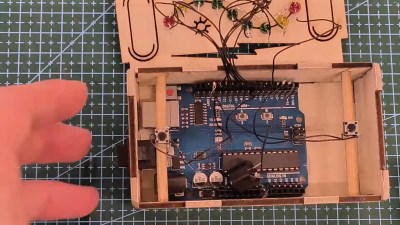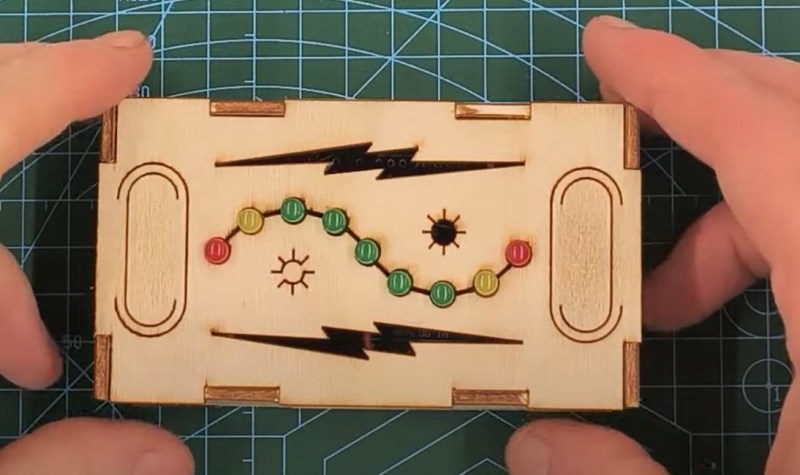Maybe it’s just us, but isn’t it kind of amazing that in a world of pretty darn realistic games, PONG is still thrilling to play? This 1D implementation by [newsonator] is about as exciting as it gets.
 It works like you’d probably expect — the light moves back and forth between the two players. Keep it in the green and you have a nice, gentle volley going. Let it hit your red LED and you’ve lost a point. But if you can push your button while your yellow LED is lit, the light speeds up tremendously until the next button press in the green.
It works like you’d probably expect — the light moves back and forth between the two players. Keep it in the green and you have a nice, gentle volley going. Let it hit your red LED and you’ve lost a point. But if you can push your button while your yellow LED is lit, the light speeds up tremendously until the next button press in the green.
Our only wish is that subsequent yellow-light button presses would make it speed up even more. But there are really just the two speeds with the current programming.
Inside the cool laser-cut box is an Arduino Uno and a 9V battery, plus a current-limiting resistor and the all-important buzzer. We like how [newsonator] wired up the LEDs to the Arduino by soldering them to a row of header pins and sticking that into the Arduino so it can be used in other projects down the line. We also like how [newsonator] shoved a couple of dowels through the box to ultimately support the two buttons.
Check out the intro video after the break for the overall details. The build is done over a few different short videos which follow.
Although this is pretty small, it isn’t quite the minimum viable.

















That’s a fine idea for a game. Well done! 😃👍
When I saw it, my first thought was how this could be implemented by TTL or relay technology.
By using a shift register or a counting chain (relay), I thought, maybe.
I believe such logic circuits or counter circuits were being used in the ~70s to build game dices et cetera.
That’s when electronic toys were the latest thing.
The running lights of Knight Rider (KIT), Battlestar Galactica (Cylons) or the old Enterprise’s view-screen had similar effects, so it must be possible the old way somehow.
That being said, the problem would be the implementation of the bat.
Making things go the other way round (the tennis ball)..
Because, the usual counters don’t go backwards. They’re rather being reset by a reset pin and start from the beginning.
What I think schould also be valued is the fact that a classic Arduino Uno was used for this project.
It’s the only model (aside from the original RS-232 model) that can be built traditionally on a veroboard (using a DIP version of the ATmega168/328P).
So this is real hacker spirit! Kudos. 🙂👍
My final project on the first semester of university was a game very similar to this one. The main difference was that you had to press the switch when the ball was on the last led of your side, and the quicker you pressed it, the faster the ball would go towards your opponent.
We didn’t use a microcontroller because it was an introductory course on digital circuits. We used TTL chips on a breadboard. One of the teachers was famous for switching some wires then asking the students to debug and fix it.
Hi Kristina, My name is Marvin, and I was inspired to build a project based on your 1D LED pong, Arduino-style project. Here is a link to my LinkedIn post on what I was able to come up with- https://www.linkedin.com/posts/marvin-ochei-913a73278_i-have-been-working-on-a-project-using-an-activity-7198715895559442433-oC1z?utm_source=share&utm_medium=member_desktop . I hope you like it and have a great day.